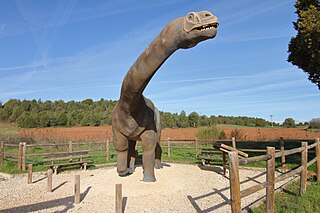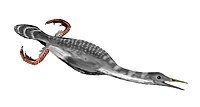
Axel Heiberg Island is an uninhabited island in the Qikiqtaaluk Region, Nunavut, Canada. Located in the Arctic Ocean, it is the 32nd largest island in the world and Canada's seventh largest island. According to Statistics Canada, it has an area of 43,178 km2 (16,671 sq mi). It is named after Axel Heiberg.

The Nemegt Formation is a geological formation in the Gobi Desert of Mongolia, dating to the Late Cretaceous. The formation consists of river channel sediments and contains fossils of fish, turtles, crocodilians, and a diverse fauna of dinosaurs, including birds.

Hațeg Island was a large offshore island in the Tethys Sea which existed during the Late Cretaceous period, probably from the Cenomanian to the Maastrichtian ages. It was situated in an area corresponding to the region around modern-day Hațeg, Hunedoara County, Romania. Maastrichtian fossils of small-sized dinosaurs have been found in the island's rocks. It was formed mainly by tectonic uplift during the early Alpine orogeny, caused by the collision of the African and Eurasian plates towards the end of the Cretaceous. There is no real present-day analog, but overall, the island of Hainan is perhaps closest as regards climate, geology and topography, though still not a particularly good match. The vegetation, for example, was of course entirely distinct from today, as was the fauna.

The Strand Fiord Formation is a Late Cretaceous volcanic component, located on northwestern and west-central Axel Heiberg Island, Nunavut, Canada. The formation contains flood basalts which are found on western Axel Heiberg Island at Dragon Cliff 300 m (980 ft) tall.
The High Arctic Large Igneous Province (HALIP) is a Cretaceous large igneous province in the Arctic. The region is divided into several smaller magmatic provinces. Svalbard, Franz Josef Land, Sverdrup Basin, Amerasian Basin, and northern Greenland are some of the larger divisions. Today, HALIP covers an area greater than 1,000,000 km2 (390,000 sq mi), making it one of the largest and most intense magmatic complexes on the planet. However, eroded volcanic sediments in sedimentary strata in Svalbard and Franz Josef Land suggest that an extremely large portion of HALIP volcanics have already been eroded away.

The Sverdrup Basin Magmatic Province is a large igneous province located on Axel Heiberg Island and Ellesmere Island, Nunavut, Canada near the rifted margin of the Arctic Ocean at the end of Alpha Ridge.
The Chenini Member is a geological member of the Ain el Guettar Formation in Tunisia, whose strata date back to the Late Aptian to Early Albian stages of the Cretaceous period. The lithology consists of coarse sandstones with occasional conglomerates and mudstones. Dinosaur remains are among the fossils that have been recovered from the formation.
The Tiourarén Formation is a geological formation in the Agadez Region of Niger whose strata were originally thought to be Early Cretaceous. However, re-interpretation of the sediments showed that they are probably Middle-Late Jurassic (Bathonian-Oxfordian) in age. It is the uppermost unit of the Irhazer Group. Dinosaur remains are among the fossils that have been recovered from the formation.
The Wapiti Formation is a geological formation of the Western Canada Sedimentary Basin in northwestern Alberta, and northeastern British Columbia, Canada. Its deposition spanned the time interval from the lower Campanian through to the upper Maastrichtian, between approximately 80 and 68 Ma. It was named by G.M. Dawson in 1881, presumably for exposures along the lower part of the Wapiti River and downstream along the Smoky River in Alberta.
The Fort Crittenden Formation is a geological formation in Arizona whose strata date back to the Late Cretaceous. Dinosaur remains are among the fossils that have been recovered from the formation.
The Laguna Palacios Formation is a Maastrichtian geologic formation of the Chubut Group in the Golfo San Jorge Basin in Patagonia, Argentina. The formation partly overlies and partly is laterally equivalent to the Lago Colhué Huapí Formation and is overlain by the Salamanca Formation of the Río Chico Group. The formation comprises tuff reworked by fluvial activity and paleosols. The Laguna Palacios Formation has provided fossilized bee nests. Dinosaur remains, such as Notoceratops, diagnostic to the genus level are among the fossils that have been recovered from the formation.

The Rupelo Formation is an Early Cretaceous (Berriasian) geologic formation in the Burgos Province of Castile and León in northern Spain. The formation crops out near the municipality Mambrillas de Lara in the northwesternmost part of the Cameros Basin in the Sierra de la Demanda.

The Villalba de la Sierra Formation is a Campanian to Maastrichtian geologic formation in Spain. Fossil dinosaur eggs have been reported from the formation, that comprises gypsiferous, grey, argillaceous mudstones and sandstones, deposited in a floodplain environment characterised by high seasonality and variability in water availability.

The Csehbánya Formation is a geological formation in the Transdanubian Mountains of Veszprém County, Hungary. The formation dates to the Late Santonian of the Late Cretaceous. It represents a floodplain environment as opposed to the swampy lacustrine environment of the simultaneous Ajka Coal Formation, though there is complete overlap in terms of fauna. It underlies the Jákó Marl Formation, and laterally transitions to the Ajka Coal Formation.
The Jeomgog Formation is an Early Cretaceous (Albian) geologic formation of the Hayang Group in the Gyeongsang Basin of South Korea.
The Piedrahita de Muñó Formation is an Early Cretaceous geologic formation of the Cameros Basin in northern Spain. Fossil theropod tracks have been reported from the formation. Also fossils of Lepidotes sp., Polacanthus sp. and Testudines indet. were found in the formation.
The Margaret Formation is a geologic formation of the Eureka Sound Group in the Sverdrup Basin in Northwest Territories and Nunavut, Canada. The unit belonging to the Eureka Sound Group which crops out at Ellesmere Island preserves fossils dating back to the Early Eocene period, or Wasatchian in the NALMA classification.

Tingmiatornis is a genus of flighted and possibly diving ornithurine bird from the High Arctic of Canada. The genus contains a single species, T. arctica, described in 2016, which lived during the Turonian epoch of the Cretaceous.

Tsagandelta is a genus of deltatheroidean therian mammal that lived in Asia during the Late Cretaceous. Distantly related to modern marsupials, it is part of Deltatheroida, a lineage of carnivorous metatherians common in the Cretaceous of Asia and among the most successful non-theropod carnivores of the region. It represents the first known mammal from the Bayan Shireh Formation.
The Aïn el Guettar Formation is a geological formation in Tunisia, whose strata date back to the Late Aptian to Early Albian stages of the Cretaceous period. The lithology consists of coarse sandstones with occasional conglomerates and mudstones. Dinosaur remains are among the fossils that have been recovered from the formation.










